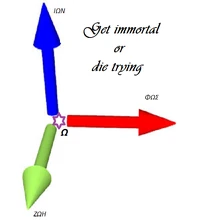Ερεσκιγάλεια
Eresh-ki-gal , <Erescigaleia>, Ερεσκιγκάλ, Ερεσκιγάλη,
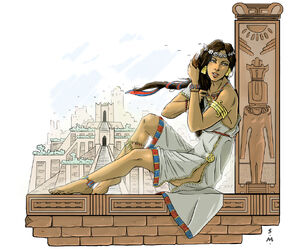
Σουμεριακή Θρησκεία
Θεοί Σουμεριακής Θρησκείας
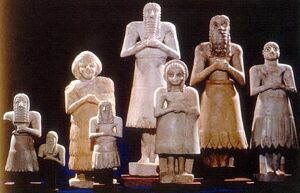
Σουμεριακή Θρησκεία
Θεοί Σουμεριακής Θρησκείας

Ερεσκιγάλεια, η θεά του Κάτω Κόσμου της Σουμεριακής Θρησκείας. Καλλιτεχνική Αναπαράσταση.
- Θεά της Σουμεριακής Θρησκείας.
- Χώρες Λατρείας: Σουμερία (κατά την 3η και 2η χιλιετηρίδα π.Χ.).
Ετυμολογία[]
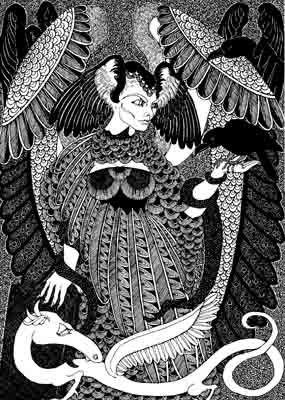
Ερεσκιγάλεια, η θεά του Κάτω Κόσμου της Σουμεριακής Θρησκείας.
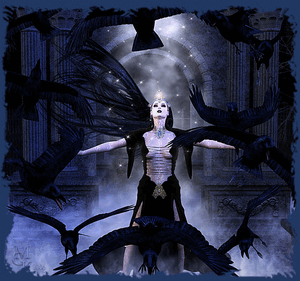
Ερεσκιγάλεια, η θεά του Κάτω Κόσμου της Σουμεριακής Θρησκείας. Καλλιτεχνική Αναπαράσταση.
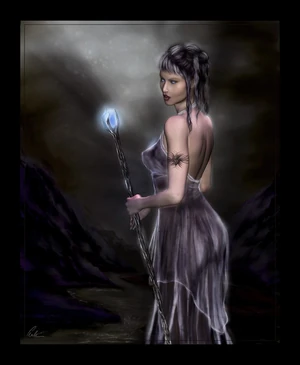
Ερεσκιγάλεια, η θεά του Κάτω Κόσμου της Σουμεριακής Θρησκείας. Καλλιτεχνική Αναπαράσταση

Ερεσκιγάλεια, η θεά του Κάτω Κόσμου της Σουμεριακής Θρησκείας. Σύγχρονη Αναπαράσταση

Ερεσκιγάλεια, η θεά του Κάτω Κόσμου της Σουμεριακής Θρησκείας. Σύγχρονη Αναπαράσταση
Το όνομά της σημαίνει η "Κυρία της Μεγάλης Γης".
Στα Σουμεριακά:
- ere = κυρία
- ki = γη
- gal = μεγάλος
Γενεαλογία[]
- Πατέρας:
- Μητέρα:
- Σύζυγος:
- Τέκνα:
Βιογραφία[]
Για τους Σουμέριους, η Ερεσκιγάλη ήταν η θεά του Κάτω Κόσμου ή αλλιώς της Ιρκάλλας, της χώρας των νεκρών.
Μερικές φορές, η ίδια η θεά ονομάζεται και Ιρκάλλα, κάτι που συνέβαινε και στην Ολυμπιακή Θρησκεία όπου η ονομασία Άδης αναφερόταν και στο θεό του Κάτω Κόσμου και στον ίδιο τον Κάτω Κόσμο.
Η Ερεσκιγάλη αναφέρεται σε μύθους ως η μεγαλύτερη αδελφή της θεάς Ινάννας. Η κάθοδος της Ινάννας στον Κάτω Κόσμο αποτελεί το θέμα του γνωστότερου μύθου σχετικά με την Ερεσκιγάλη.
Είναι η μητέρα του θεού Νουνγκάλ.
Από τον Ένλιλο απέκτησε τον θεό Ναμτάρ.
Ανάλυση[]
In Σουμερική Θρησκεία, Ereshkigal (DEREŠ.KI.GAL, lit. "great lady under earth") was the goddess of Irkalla, the land of the dead or underworld. Sometimes her name is given as Irkalla, similar to way the name Hades was used in Greek mythology for both the underworld and its ruler.
Ereshkigal was the only one who could pass judgement and give laws in her kingdom. The main temple dedicated to her was located in Cuthah.[1]
The goddess Ishtar refers to Ereshkigal as her older sister in the Sumerian hymn "The Descent of Ishtar" (which was also in later Babylonian myth still called "The Descent of Ishtar"). Inanna/Ishtar's trip and return to the underworld is the most familiar of the myths concerning Ereshkigal.
Βασικοί Μύθοι[]
She is known chiefly through two myths, believed to symbolize the changing of the seasons, but perhaps also intended to illustrate certain doctrines developed in the temple-schools of Babylonia. Ereshkigal is therefore the sister of Ishtar and from one point of view her counterpart, the symbol of nature during the non-productive season of the year. As the doctrine of two kingdoms, one of this world and one of the world of the dead, becomes crystallized, the dominions of the two sisters are sharply differentiated from one another.
One of these myths is the famous story of Ishtar's descent to Irkalla or Aralu, as the lower world was called, and her reception by her sister who presides over it; the other is the story of Nergal, the plague god, whose offence against Ereshkigal, his banishment to the kingdom controlled by the goddess and the reconciliation between Nergal and Ereshkigal through the latter's offer to have Nergal share the honors of the rule over Irkalla. In later tradition, Nergal is said to have been the victor, taking her as wife and ruling the land himself.
It is theorized that the story of Ishtar's descent is told to illustrate the possibility of an escape from Irkalla, while the other myth is intended to reconcile the existence of two rulers of Irkalla: a goddess and a god. The addition of Nergal represents the harmonizing tendency to unite with Ereshkigal as the queen of the netherworld to the god who, in his character as god of war and of pestilence, conveys the living to Irkalla and thus becomes the one who presides over the dead.
In some versions of the myths, she rules the underworld by herself, sometimes with a husband subordinate to her named Gugalana. It was said that she had been stolen away by Kur and taken to the underworld, where she was made queen unwillingly. [1]
She is the mother of the goddess Nungal. Her son with Enlil was the god Namtar. With Gugalana her son was Ninazu.
Λατρεία[]
Οι σημαντικότερες τελετές προς τιμήν της ήταν:
Υποσημειώσεις[]
- ↑ "Ereshkigal", Encyclopedia Britannica Ultimate Reference Suite DVD, 2003.
Εσωτερική Αρθρογραφία[]
- Σουμερία
- Ηγεμόνες Σουμερίας
- Σουμεριακή Θρησκεία
- Ακαδδική Θρησκεία
- Βαβυλωνιακή Θρησκεία
Βιβλιογραφία[]
| της Σουμεριακής Θρησκείας
|
|---|
|
- Gods, Demons and Symbols of Ancient Mesopotamia by Jeremy Black and Anthony Green (ISBN 0-292-70794-0)
- The Gilgamesh Epic and Old Testament Parallels by Alexander Heidel (ISBN 0-226-32398-6)
- Inanna: Queen of Heaven and Earth" by Diane Wolkenstein and Sumuel Noah Kramer (ISBN 0-06-090854-8)
Ιστογραφία[]
- Ομώνυμο άρθρο στην Βικιπαίδεια
- Ομώνυμο άρθρο στην Livepedia
- Ετυμολογική ερμηνεία
- pantheon.org
- "Inana's descent to the nether world" - from The Electronic Text Corpus of Sumerian Literature by the Oriental Institute of the University of Oxford
|
Αν και θα βρείτε εξακριβωμένες πληροφορίες "Οι πληροφορίες αυτές μπορεί πρόσφατα Πρέπει να λάβετε υπ' όψη ότι Επίσης, |
- Μην κάνετε χρήση του περιεχομένου της παρούσας εγκυκλοπαίδειας
αν διαφωνείτε με όσα αναγράφονται σε αυτήν
- Όχι, στις διαφημίσεις που περιέχουν απαράδεκτο περιεχόμενο (άσεμνες εικόνες, ροζ αγγελίες κλπ.)
